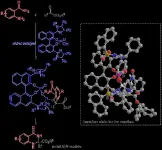New method for asymmetric N,N-acetal synthesis promises advances in drug development
Scientists identify new method of preparing N,N-acetals with high enantiopurity using diketones, crowning a new approach to synthesizing bioactive drugs
2021-02-09
(Press-News.org) A lot of our medicines and other bioactive drugs are based on chemical structures called "enantiomers"-- molecules that are mirror images of each other and are non-superimposable. Notable among them are chiral N,N-acetals contained in diuretic drugs like bendroflumethiazide and thiabutazide, used to treat high blood pressure and edema. Because an enantiomer and its mirror image version often have different biological activities, with only one of them having pharmacological utility, an "enantioselective" or asymmetric synthesis yielding the desired enantiomer in greater amounts is highly desirable.
In the case of N,N-acetals, several studies have demonstrated their enantioselective preparation from aldehydes, aldimines, or enamines. However, in all these cases, their reaction partner has been limited to aldehyde or imines. While ketones have been employed, with instances of successful enantioselective N,N-acetal synthesis, their use--in general--is not considered effective.
In a recent study published in Advanced Synthesis & Catalysis, scientists from Nagoya Institute of Technology (NITech) and Osaka University in Japan explored this situation with an enantioselective synthesis of chiral N,N-acetals from α-dicarbonyl compounds--compounds with two carbonyl (ketone) groups on the α-carbon--in presence of chiral imidazoline phosphoric acid catalysts, and obtained yields as high as 99% with a maximum enantiopurity of 96%.
"Our study presents the first highly stereoselective formation of chiral N,N-acetals from α-ketoesters using an original catalyst that can be used for other stereoselective synthetic reactions as well," says Prof. Shuichi Nakamura from NITech, who led the study.
The scientists began by examining the reaction of 2-aminobenzamide with various α-ketoesters in presence of different catalysts. The α-ketoesters differed from one another in the nature of the functional group attached to the α-carbon, while the catalysts chosen were bis(imidazoline)-phosphoric acid with different substituents attached to the nitrogen in the imidazoline ring, mono-imidazoline-phosphoric acid, and two commercial chiral phosphoric acids. Among these various combinations, scientists found the best yield (99%) and enantiopurity (92%) in the case of α-ketoester with benzhydryl group and a bis(imidazoline)-phosphoric acid catalyst with 1-naphthalenesulfonyl group.
Scientists next examined the reaction of various aminobenzamides (bearing either an electron-donating methyl group or electron-withdrawing fluoro, chloro, and bromo groups) with different α-ketoesters (containing the same benzhydryl group but different functional groups in place of an earlier phenyl group) keeping the same bis(imidazoline)-phosphoric acid catalyst with 1-naphthalenesulfonyl group. All the combinations showed good yield (77-95%) along with high enantioselectivity (82-96%).
In addition, the team looked at the enantioselective synthesis of N,N-acetals via the reaction of N-benzyl isatin (a cyclic α-ketoamide), benzil (an acyclic diketone), and benzaldehyde with 2-aminobenzamide for the same catalyst. All three reactions yielded products with high enantiopurity (91-93%).
The team also proposed a possible mechanism for the N,N-acetal formation reaction corresponding to the best yield (99%), involving a ketimine intermediate with an amide group that helps avoid steric repulsion between the phenyl group on imidazoline, enabling the formation of an (R)-isomer with high enantiopurity.
While the mechanism is still speculative and requires further investigation, scientists are excited about the potential implications of the experimental results. "Our new method will enable the synthesis of candidate pharmaceutical drugs that are currently difficult to synthesize, and can even potentially help create and provide people with new and better medicines in the future," concludes Prof. Nakamura.
Now, those are some promising consequences to look forward to!
INFORMATION:
This study was made available online in October 2020 ahead of final publication in issue on December 8, 2020.
About Nagoya Institute of Technology, Japan
Nagoya Institute of Technology (NITech) is a respected engineering institute located in Nagoya, Japan. Established in 1949, the university aims to create a better society by providing global education and conducting cutting-edge research in various fields of science and technology. To this end, NITech provides a nurturing environment for students, teachers, and academicians to help them convert scientific skills into practical applications. Having recently established new departments and the "Creative Engineering Program," a 6-year integrated undergraduate and graduate course, NITech strives to continually grow as a university. With a mission to "conduct education and research with pride and sincerity, in order to contribute to society," NITech actively undertakes a wide range of research from basic to applied science.
Website: https://www.nitech.ac.jp/eng/index.html
About Dr. Shuichi Nakamura from Nagoya Institute of Technology, Japan
Dr. Shuichi Nakamura is Professor at the Department of Life and Materials Chemistry at Nagoya Institute of Technology (NITech), Japan. He studied organic chemistry at NITech, where he received his PhD in 2001 and joined as Assistant Professor in the same year. His current research interests include asymmetric reactions and asymmetric catalysts. He has received the Inoue Research Award for Young Scientists (2001) for his Ph. D. thesis and several others. He has 145 publications to his credit with over 6000 citations and has co-authored 7 books.
[Attachments] See images for this press release:

ELSE PRESS RELEASES FROM THIS DATE:
2021-02-09
CLEVELAND (Feb. 9)--A study led by Case Western Reserve University researchers found that patients with dementia were at a significantly increased risk for COVID-19--and the risk was higher still for African Americans with dementia.
Reviewing electronic health records of 61.9 million adults in the United States, researchers found the risk of contracting COVID-19 was twice as high for patients with dementia than for those without it--while among those with dementia, African Americans had close to three times the risk of being infected with COVID-19 as Caucasians did.
In addition, patients with dementia who ...
2021-02-09
KEY STUDY FINDINGS INCLUDE:
2.9% of U.S. adults report a current peanut allergy.
About one in six adults with a peanut allergy developed it after age 18.
Approximately one in five adults with peanut allergy report visiting the emergency department for food allergy treatment each year.
Patients who developed their peanut allergy during adulthood are less likely to report having an epinephrine auto-injector prescription than those who developed their peanut allergy during childhood, despite similar frequencies of severe reactions among both groups.
CHICAGO --- Peanut allergy affects at least 4.5 million adults in the U.S., many of whom report developing their ...
2021-02-09
Researchers at Baylor College of Medicine and other institutions have identified a novel strategy that can eliminate bacteria in a specific location before they cause an infection. The strategy uses a phage, a virus that infects and destroys bacteria, that can specifically locate in the same place the bacteria live in the gastrointestinal tract. The proximity between phage and bacteria facilitates the phage's attack and subsequent elimination of the bacteria.
This strategy has the potential of becoming a game changer in the fight against antibiotic-resistant bacteria ...
2021-02-09
DALLAS, Feb. 9, 2021 -- Participants in a two-year, lifestyle intervention/weight-loss program provided through health coaches at their primary care center were able to lower their blood sugar and improve their cholesterol levels, according to new research published today in the American Heart Association's flagship journal Circulation Journal. Researchers with the PROmoting Successful Weight Loss in Primary CarE in Louisiana (PROPEL) Trial reported previously that participants also reduced body weight by an average of 5% and note that patients who lost more weight experienced greater improvements in their heart disease risk factors.
"Our results demonstrate lifestyle intervention and weight-loss programs can be successful for people in underserved, low-income ...
2021-02-09
DALLAS, Feb. 9, 2021 -- Dietary information from three large, well-known heart disease studies suggests drinking one or more cups of caffeinated coffee may reduce heart failure risk, according to research published today in Circulation: Heart Failure, an American Heart Association journal.
Coronary artery disease, heart failure and stroke are among the top causes of death from heart disease in the U.S. "While smoking, age and high blood pressure are among the most well-known heart disease risk factors, unidentified risk factors for heart disease remain," according to David P. Kao, M.D., senior author of the study, assistant professor of cardiology and medical director at the Colorado Center for Personalized Medicine at the University of Colorado School of Medicine ...
2021-02-09
In 2017, a widely cited study used statistical tools to model how likely the world is to meet the Paris Agreement global temperature targets. The analysis found that on current trends, the planet had only a 5% chance of staying below 2 degrees Celsius warming this century -- the international climate treaty's supposed goal.
Now, the same authors have used their tools to ask: What emissions cuts would actually be required to meet the goal of 2 C warming, considered a threshold for climate stability and climate-related risks such as excessive heat, drought, extreme weather and sea level rise?
The University of Washington study finds that emissions reductions about 80% more ambitious than those in the Paris Agreement, or an average of 1.8% drop in emissions per year rather than 1% ...
2021-02-09
New research led by Monterey Bay Aquarium reveals that even the revered white shark cannot escape the impacts of a changing ocean. The study, published in Scientific Reports, finds that unprecedented sightings of juvenile white sharks at the northern end of Monterey Bay signal a significant shift in the young white sharks' range.
Researchers conclude the northward range shift demonstrates the young sharks are being subjected to a loss of suitable thermal habitat, meaning water temperatures within their preferred temperature range are becoming harder to find.
"Nature has many ways to tell us the status quo is being disrupted, but it's up to us to listen," said Monterey Bay Aquarium Chief Scientist Dr. Kyle Van Houtan. "These sharks - by venturing into territory where they have not historically ...
2021-02-09
Our consumer products, such as food, cosmetics and clothes, might be filled with nanomaterials - unbeknownst to us. The use of nanomaterials remains unregulated and they do not show up in lists of ingredients. This is a cause of concern since nanomaterials can be more dangerous than COVID-19 in the long term if no safety action is taken: they are tricky to measure, they enter our food chain and, most alarmingly, they can penetrate cells and accumulate in our organs.
Nanotechnology is appearing everywhere, to change our daily lives. Thanks to applications of nanotechnology, we can treat many diseases so efficiently that they'll soon be a thing of the past. We also have materials that are 100 times stronger than steel, batteries that last 10 times longer than ...
2021-02-09
The term plankton describes usually very small organisms that drift with the currents in the seas and oceans. Despite their small size, they play an important role for our planet due to their immense quantity. Photosynthesizing plankton, known as phytoplankton, for example, produce half of the oxygen in the atmosphere while binding huge amounts of carbon dioxide (CO2). Since the Southern Ocean around Antarctica is very rich in nutrients, phytoplankton can thrive there. It is therefore a key region for controlling atmospheric CO2 concentrations.
As other nutrients are abundant, scientists have ...
2021-02-09
Exposure to radiation can wreak indiscriminate havoc on cells, tissues, and organs. Curiously, however, some tissues are more vulnerable to radiation damage than others.
Scientists have known these differences involve the protein p53, a well-studied tumor-suppressor protein that initiates a cell's auto-destruct programs. Yet, levels of this sentinel protein are often similar in tissues with vastly different sensitivities to radiation, posing the question: How is p53 involved?
A new study by researchers in the Blavatnik Institute at Harvard Medical School, Massachusetts General Hospital, and the Novartis Institutes for BioMedical Research now sheds light on this mystery.
Reporting in Nature Communications on Feb. 9, they describe how cellular survival after radiation exposure depends ...
LAST 30 PRESS RELEASES:
[Press-News.org] New method for asymmetric N,N-acetal synthesis promises advances in drug development
Scientists identify new method of preparing N,N-acetals with high enantiopurity using diketones, crowning a new approach to synthesizing bioactive drugs



